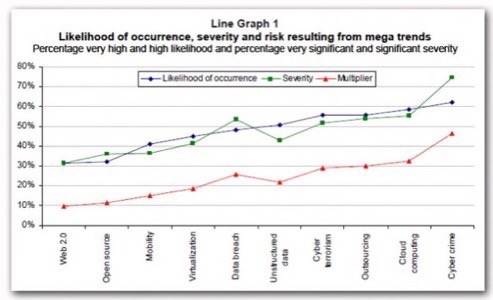Mobile technology, virtualization, the social web, cloud computing – a think tank study has all our good friends on a hit list.

The study, which shows primary security and privacy concerns of U.S. government IT leaders, is making the rounds among military and government bloggers. Policy makers are being told that the applications we know and love are dangerous and pose gaping security loopholes for cyberterrorism. Is a Big Brother overprotective meltdown? Or are our advances really causing greater risks for all users?
The infosec-focused Ponemon Institute polled 217 senior-level IT executives located in various federal organizations. They called out these as the top 5 trends in Internet technologies that – at least from their POVs – put businesses, governments, and users at risk:
- 79% Unstructured data
- 71% Cyber terrorism
- 63% Mobility
- 52% Web 2.0
- 44% Virtualization


Some of these trends are quite longstanding; however, they still cause a great deal of concern among our friends in infosec. Data breach (40%), cyber crime (40%), cloud computing (39%), outsourcing (34%) and open source applications (18%) also top the study’s list of security vulnerabilities as seen through the eyes of government IT pros.
However, Vivek Kundra, a 2.0 champion and federal CIO, said in a recent post, “Our policies lag behind new trends, causing unnecessary restrictions on the use of new technology…
‘This technology supports every mission our government performs – from defending our borders to protecting the environment. IT is essential for the government to do its work, and it is essential that we have access to the latest and most innovative technologies.”
It’s sad and frightening to see mobile tech, social networks, and cloud computing called out alongside cyber crime and cyberterrorism as perceived threats to data security. But how much validity do U.S. leaders’ fears carry?
The Ponemon Institute reports, “IT operations and IT security professionals identified cloud computing, outsourcing of sensitive information to third parties, external threat of
organized cyber criminal syndicates, cyber terrorism, and a mobile workforce… We believe the findings from this study provide government organizations with guidance on which threats are more critical than others to address.”
What do you think about the assessment of these high-profile and popular trends being identified as threats by IT execs in government? Is this a case of out-of-touch government bigwigs cracking down on the social web when black hat hackers are truly to blame? Or are so-called social media experts remiss in their duties to ensure that any products they roll out are secure enough for across-the-board use?
Or is it a little bit of both?
Most importantly, how do we solve the problem of ensuring that government and corporate sensitive information remains secure while users get to enjoy the benefits of Internet-based applications?
We welcome your comments below.

















